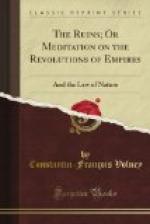** If it was for this
reason the Persians always wrote the
name of Ahrimanes inverted
thus: [’Ahrimanes’ upside down
and backwards].
*** Typhon, pronounced Touphon by the Greeks, is precisely the touphan of the Arabs, which signifies deluge; and these deluges in mythology are nothing more than winter and the rains, or the overflowing of the Nile: as their pretended fires which are to destroy the world, are simply the summer season. And it is for this reason that Aristotle (De Meteor, lib. I. c. xiv), says, that the winter of the great cyclic year is a deluge; and its summer a conflagration. “The Egyptians,” says Porphyry, “employ every year a talisman in remembrance of the world: at the summer solstice they mark their houses, flocks and trees with red, supposing that on that day the whole world had been set on fire. It was also at the same period that they celebrated the pyrric or fire dance.” And this illustrates the origin of purification by fire and by water; for having denominated the tropic of Cancer the gate of heaven, and the genial heat of celestial fire, and that of Capricorn the gate of deluge or of water, it was imagined that the spirit or souls who passed through these gates in their way to and from heaven, were roasted or bathed: hence the baptism of Mithra; and the passage through flames, observed throughout the East long before Moses.
**** That is when the
ram became the equinoctial sign, or
rather when the alteration
of the skies showed that it was
no longer the bull.
“In Syria, it was the hog or wild boar, enemy of Adonis; because in that country the functions of the Northern Bear were performed by the animal whose inclination for mire and dirt was emblematic of winter. And this is the reason, followers of Moses and Mahomet! that you hold him in horror, in imitation of the priests of Memphis and Balbec, who detested him as the murderer of their God, the sun. This likewise, O Indians! is the type of your Chib-en; and it has been likewise




